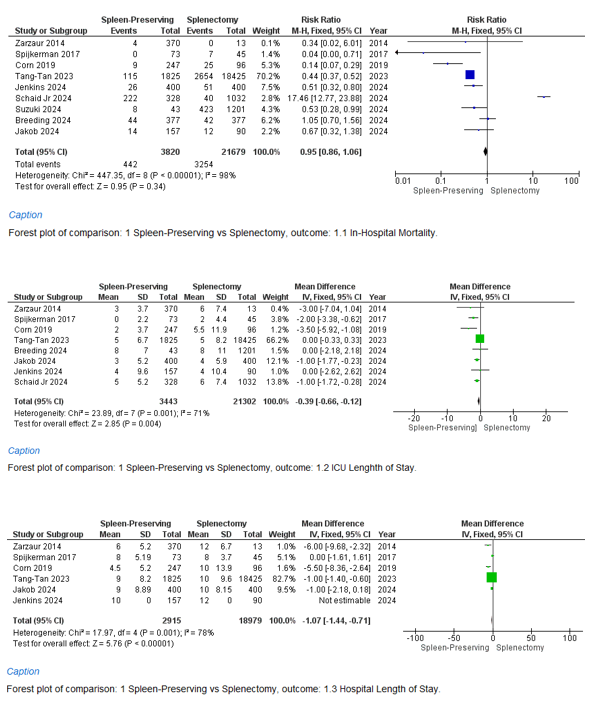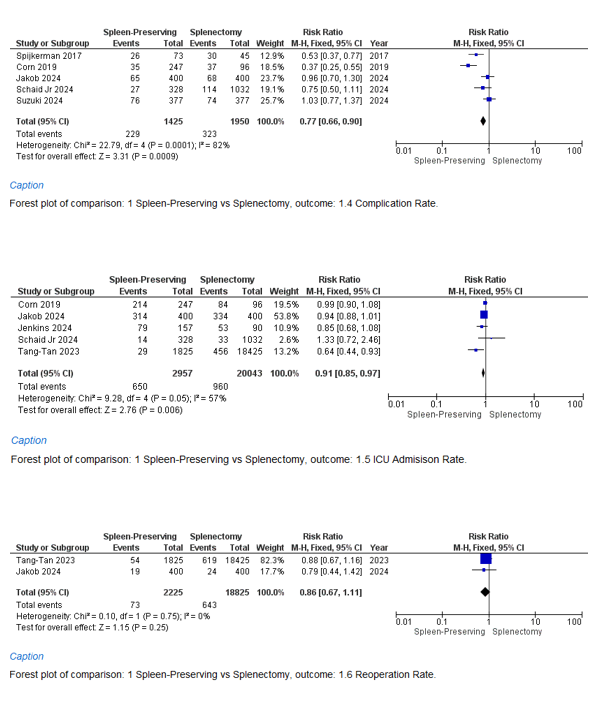Monday Poster Session
Category: Stomach and Spleen
P4172 - Spleen Preservation Techniques versus Splenectomy in Traumatic Splenic Injury: A Systematic Review and Meta-Analysis of Clinical Outcomes in Adults
Monday, October 27, 2025
10:30 AM - 4:00 PM PDT
Location: Exhibit Hall

Aakash Aakash, MD (he/him/his)
Florida State University
Cape Coral, FL
Presenting Author(s)
Diksha Mahadeva Gowda, MBBS1, Aakash Aakash, MD2, Aasta Kumari, MD3, Ahmed Zaki, MBBCh4, Yeshika Thapa, MD5, Kushaghar Singla, MD6, Dheeraj Kumar Maheshwari, MBBS7, Adarsh Gande, MBBS8, Binay Panjiyar, MD9, Sri Lakshmi Ananya Bokka, MBBS10, Siddhi P. Shah, MBBS11, Chandana Tadigotla, MBBS12, Faizan ul Hussain Mohammed, MBBS13, Afreen Begum, MBBS14, Omer Farooq Mohammed, MBBS15, Adi Prasad Bodapati, MD16, Ashwith Reddy Gaddam, MD17
1Mayo Clinic, Rochester, MN; 2Florida State University, Cape Coral, FL; 3North Central Bronx Hospital, New York, NY; 4Mayo Clinic Hospital, Rochester, MN; 5University of Central Florida, Gainesville, FL; 6University of Pennsylvania Health System, Claymont, DE; 7Liaquat University of Medical and Health Science, Pensacola, FL; 8JIPMER, Pondicherry, India, Southlake, TX; 9NorthShore University Hospital, Manhasset, NY; 10Gandhi Medical College & Hospital, Hyderabad, Telangana, India; 11HBT Medical College and Dr. R.N. Cooper Municipal General Hospital, Thane, Maharashtra, India; 12PES INSTITUTE OF MEDICAL SCIENCES AND RESEARCH, Ananthapur, Andhra Pradesh, India; 13Osmania Medical College, Karimnagar, Telangana, India; 14ESIC Medical College and Hospital, Washington, DC; 15Osmania General Hospital and Medical College, Hyderabad, Telangana, India; 16Texas Tech University Health Sciences Center, Odessa, TX; 17NYMC at St. Mary’s General hospital amd st clares health, Parsippany, NJ
Introduction: Traumatic splenic injuries, often resulting from blunt or penetrating abdominal trauma, pose a critical management dilemma that requires a careful balance between prompt hemorrhage control and preservation of long-term immunologic function. While splenectomy remains standard for unstable patients, spleen-preserving approaches such as nonoperative management (NOM), splenic artery embolization (SAE), and splenorrhaphy are increasingly favored in stable cases to avoid asplenia-related risks like overwhelming infection. This systematic review and meta-analysis evaluates and compares clinical outcomes between spleen-preservation techniques and splenectomy in adult trauma patients.
Methods: A systematic search was performed in PubMed, Embase, MEDLINE, Cochrane Library, and Google Scholar for studies published from 2010 through May 2025. Eligible studies included randomized controlled trials and observational studies comparing spleen-preserving techniques versus splenectomy in adults with traumatic splenic injury. Two reviewers independently extracted data. Pooled risk ratios (RRs) and mean differences (MDs) with 95% confidence intervals (CIs) were calculated using a fixed-effects model in RevMan 5.4.1. Primary outcomes included in-hospital mortality, ICU length of stay (LOS), and hospital LOS. Secondary outcomes included complication rates, ICU readmissions, and reoperation rates.
Results: Nine studies comprising 43,027 patients were included. Spleen-preserving techniques were associated with a reduced risk of in-hospital mortality compared to splenectomy, though this difference was not statistically significant (RR 0.95; 95% CI: 0.86–1.06). However, spleen preservation techniques significantly reduced ICU LOS (MD –0.39 days; 95% CI: –0.66 to –0.12) and hospital LOS (MD –1.07 days; 95% CI: –1.44 to –0.71). Additionally, patients undergoing spleen-preserving treatment had significantly lower complication rates (RR 0.77; 95% CI: 0.66–0.90) and ICU readmission rates (RR 0.91; 95% CI: 0.85–0.97). No significant difference was observed in reoperation rates (RR 0.86; 95% CI: 0.67–1.11)
Discussion: Spleen-preserving techniques in adult trauma patients are associated with significantly fewer complications, shorter ICU and hospital stays, and reduced ICU readmissions, without increased mortality or reoperation risk. Our findings support the use of spleen-preserving strategies in appropriately selected patients, reinforcing their role as a safe and effective alternative to splenectomy.

Figure: Forest Plot evaluating the Primary Outcome

Figure: Forest Plot evaluating the Secondary Outcome
Disclosures:
Diksha Mahadeva Gowda indicated no relevant financial relationships.
Aakash Aakash indicated no relevant financial relationships.
Aasta Kumari indicated no relevant financial relationships.
Ahmed Zaki indicated no relevant financial relationships.
Yeshika Thapa indicated no relevant financial relationships.
Kushaghar Singla indicated no relevant financial relationships.
Dheeraj Kumar Maheshwari indicated no relevant financial relationships.
Adarsh Gande indicated no relevant financial relationships.
Binay Panjiyar indicated no relevant financial relationships.
Sri Lakshmi Ananya Bokka indicated no relevant financial relationships.
Siddhi Shah indicated no relevant financial relationships.
Chandana Tadigotla indicated no relevant financial relationships.
Faizan ul Hussain Mohammed indicated no relevant financial relationships.
Afreen Begum indicated no relevant financial relationships.
Omer Farooq Mohammed indicated no relevant financial relationships.
Adi Prasad Bodapati indicated no relevant financial relationships.
Ashwith Reddy Gaddam indicated no relevant financial relationships.
Diksha Mahadeva Gowda, MBBS1, Aakash Aakash, MD2, Aasta Kumari, MD3, Ahmed Zaki, MBBCh4, Yeshika Thapa, MD5, Kushaghar Singla, MD6, Dheeraj Kumar Maheshwari, MBBS7, Adarsh Gande, MBBS8, Binay Panjiyar, MD9, Sri Lakshmi Ananya Bokka, MBBS10, Siddhi P. Shah, MBBS11, Chandana Tadigotla, MBBS12, Faizan ul Hussain Mohammed, MBBS13, Afreen Begum, MBBS14, Omer Farooq Mohammed, MBBS15, Adi Prasad Bodapati, MD16, Ashwith Reddy Gaddam, MD17. P4172 - Spleen Preservation Techniques versus Splenectomy in Traumatic Splenic Injury: A Systematic Review and Meta-Analysis of Clinical Outcomes in Adults, ACG 2025 Annual Scientific Meeting Abstracts. Phoenix, AZ: American College of Gastroenterology.
1Mayo Clinic, Rochester, MN; 2Florida State University, Cape Coral, FL; 3North Central Bronx Hospital, New York, NY; 4Mayo Clinic Hospital, Rochester, MN; 5University of Central Florida, Gainesville, FL; 6University of Pennsylvania Health System, Claymont, DE; 7Liaquat University of Medical and Health Science, Pensacola, FL; 8JIPMER, Pondicherry, India, Southlake, TX; 9NorthShore University Hospital, Manhasset, NY; 10Gandhi Medical College & Hospital, Hyderabad, Telangana, India; 11HBT Medical College and Dr. R.N. Cooper Municipal General Hospital, Thane, Maharashtra, India; 12PES INSTITUTE OF MEDICAL SCIENCES AND RESEARCH, Ananthapur, Andhra Pradesh, India; 13Osmania Medical College, Karimnagar, Telangana, India; 14ESIC Medical College and Hospital, Washington, DC; 15Osmania General Hospital and Medical College, Hyderabad, Telangana, India; 16Texas Tech University Health Sciences Center, Odessa, TX; 17NYMC at St. Mary’s General hospital amd st clares health, Parsippany, NJ
Introduction: Traumatic splenic injuries, often resulting from blunt or penetrating abdominal trauma, pose a critical management dilemma that requires a careful balance between prompt hemorrhage control and preservation of long-term immunologic function. While splenectomy remains standard for unstable patients, spleen-preserving approaches such as nonoperative management (NOM), splenic artery embolization (SAE), and splenorrhaphy are increasingly favored in stable cases to avoid asplenia-related risks like overwhelming infection. This systematic review and meta-analysis evaluates and compares clinical outcomes between spleen-preservation techniques and splenectomy in adult trauma patients.
Methods: A systematic search was performed in PubMed, Embase, MEDLINE, Cochrane Library, and Google Scholar for studies published from 2010 through May 2025. Eligible studies included randomized controlled trials and observational studies comparing spleen-preserving techniques versus splenectomy in adults with traumatic splenic injury. Two reviewers independently extracted data. Pooled risk ratios (RRs) and mean differences (MDs) with 95% confidence intervals (CIs) were calculated using a fixed-effects model in RevMan 5.4.1. Primary outcomes included in-hospital mortality, ICU length of stay (LOS), and hospital LOS. Secondary outcomes included complication rates, ICU readmissions, and reoperation rates.
Results: Nine studies comprising 43,027 patients were included. Spleen-preserving techniques were associated with a reduced risk of in-hospital mortality compared to splenectomy, though this difference was not statistically significant (RR 0.95; 95% CI: 0.86–1.06). However, spleen preservation techniques significantly reduced ICU LOS (MD –0.39 days; 95% CI: –0.66 to –0.12) and hospital LOS (MD –1.07 days; 95% CI: –1.44 to –0.71). Additionally, patients undergoing spleen-preserving treatment had significantly lower complication rates (RR 0.77; 95% CI: 0.66–0.90) and ICU readmission rates (RR 0.91; 95% CI: 0.85–0.97). No significant difference was observed in reoperation rates (RR 0.86; 95% CI: 0.67–1.11)
Discussion: Spleen-preserving techniques in adult trauma patients are associated with significantly fewer complications, shorter ICU and hospital stays, and reduced ICU readmissions, without increased mortality or reoperation risk. Our findings support the use of spleen-preserving strategies in appropriately selected patients, reinforcing their role as a safe and effective alternative to splenectomy.

Figure: Forest Plot evaluating the Primary Outcome

Figure: Forest Plot evaluating the Secondary Outcome
Disclosures:
Diksha Mahadeva Gowda indicated no relevant financial relationships.
Aakash Aakash indicated no relevant financial relationships.
Aasta Kumari indicated no relevant financial relationships.
Ahmed Zaki indicated no relevant financial relationships.
Yeshika Thapa indicated no relevant financial relationships.
Kushaghar Singla indicated no relevant financial relationships.
Dheeraj Kumar Maheshwari indicated no relevant financial relationships.
Adarsh Gande indicated no relevant financial relationships.
Binay Panjiyar indicated no relevant financial relationships.
Sri Lakshmi Ananya Bokka indicated no relevant financial relationships.
Siddhi Shah indicated no relevant financial relationships.
Chandana Tadigotla indicated no relevant financial relationships.
Faizan ul Hussain Mohammed indicated no relevant financial relationships.
Afreen Begum indicated no relevant financial relationships.
Omer Farooq Mohammed indicated no relevant financial relationships.
Adi Prasad Bodapati indicated no relevant financial relationships.
Ashwith Reddy Gaddam indicated no relevant financial relationships.
Diksha Mahadeva Gowda, MBBS1, Aakash Aakash, MD2, Aasta Kumari, MD3, Ahmed Zaki, MBBCh4, Yeshika Thapa, MD5, Kushaghar Singla, MD6, Dheeraj Kumar Maheshwari, MBBS7, Adarsh Gande, MBBS8, Binay Panjiyar, MD9, Sri Lakshmi Ananya Bokka, MBBS10, Siddhi P. Shah, MBBS11, Chandana Tadigotla, MBBS12, Faizan ul Hussain Mohammed, MBBS13, Afreen Begum, MBBS14, Omer Farooq Mohammed, MBBS15, Adi Prasad Bodapati, MD16, Ashwith Reddy Gaddam, MD17. P4172 - Spleen Preservation Techniques versus Splenectomy in Traumatic Splenic Injury: A Systematic Review and Meta-Analysis of Clinical Outcomes in Adults, ACG 2025 Annual Scientific Meeting Abstracts. Phoenix, AZ: American College of Gastroenterology.
